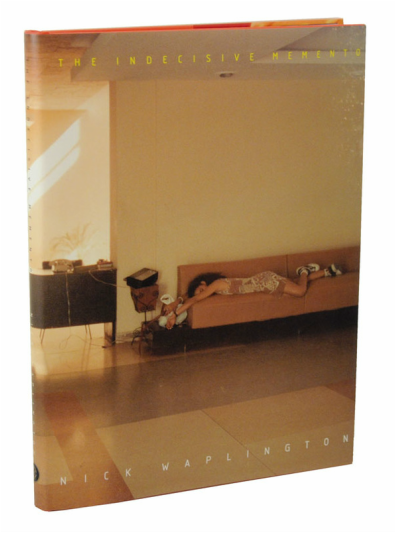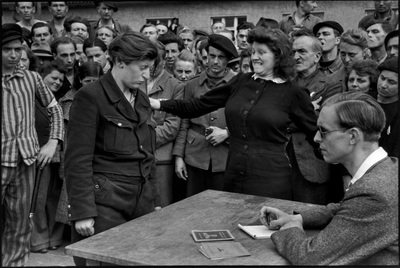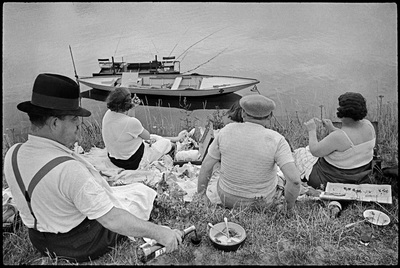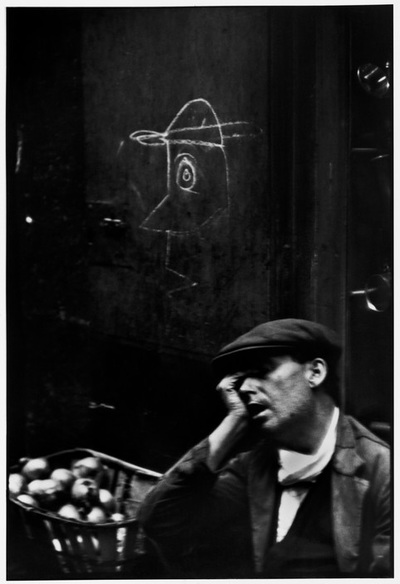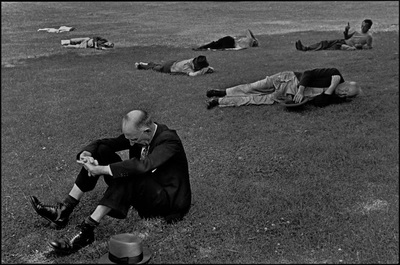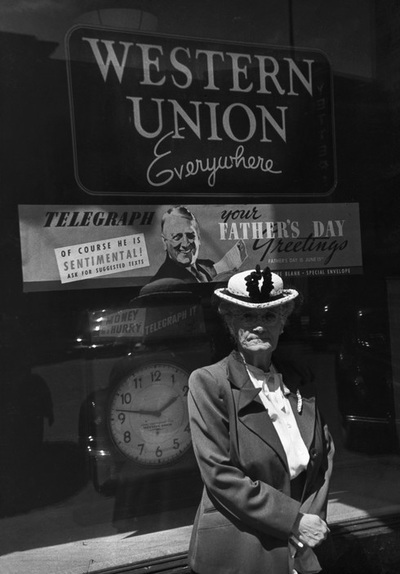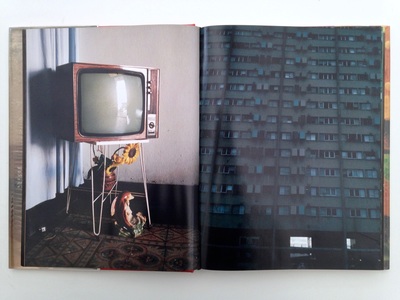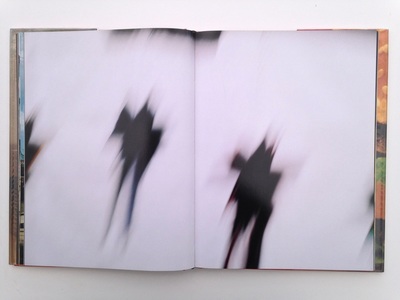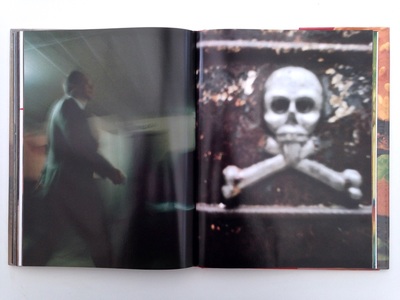Post 16 lesson plan:
Exploring the relationship between photographs, time and memory with Henri Cartier-Bresson, Nick Waplington and others.
Photography is often conceived of as a time-based medium. The camera, unlike our eyes, has the ability to freeze time, to take a slice of out of the ongoing flux of life, to select and frame a moment so that we can return to it and explore its details. Of course, this isn't the only way to think about photography but it's a powerful and important concept about the way photographic images work and how they alter our sense of reality.
The history of photography is, in part, the history of photographic books (since this has been one of the major ways in which photographers have been able to share their work) and one of the most significant books ever published by a photographer is 'The Decisive Moment' by Henri Cartier-Bresson. This project is designed to encourage students to reflect on some of the images in Cartier-Bresson's book, to think about the model of photographic practice they represent and to consider alternative ways to think about the relationship between photography and moments in time, with a particular focus on Nick Waplington's book 'The Indecisive Memento'. Waplington's obvious reference to Cartier-Bresson is a challenge to some of the conventions or expectations of the role of photography and the photographer. In an age of ubiquitous digital photography and social media, how might we re-think our relationship to photographic moments and the documentary tradition?
The history of photography is, in part, the history of photographic books (since this has been one of the major ways in which photographers have been able to share their work) and one of the most significant books ever published by a photographer is 'The Decisive Moment' by Henri Cartier-Bresson. This project is designed to encourage students to reflect on some of the images in Cartier-Bresson's book, to think about the model of photographic practice they represent and to consider alternative ways to think about the relationship between photography and moments in time, with a particular focus on Nick Waplington's book 'The Indecisive Memento'. Waplington's obvious reference to Cartier-Bresson is a challenge to some of the conventions or expectations of the role of photography and the photographer. In an age of ubiquitous digital photography and social media, how might we re-think our relationship to photographic moments and the documentary tradition?
The Decisive Moment
Photography is the simultaneous recognition, in a fraction of a second, of the significance of an event as well as of a precise organisation of forms which give that event its proper expression.
This famous formulation of the essence of photography can be found in the introduction to Cartier-Bresson's 1947 book 'The Decisive Moment'. He began photographing seriously in the 1930s, influenced by the Surrealists and their understanding of the camera's ability to create a new reality. The book is divided into two chronological and geographical sections: the first spans the years 1932 to 1947 and is made up of photographs taken in the west; the second spans 1947 to 1952 and was shot mostly in the east. Cartier-Bresson was obsessed with form and composition, with the aesthetics of photography. His images are momentary glimpses of reality but organised into a geometric pattern. This desire to organise and control has drawn admiration and criticism:
The reason his photographs often feel numbly impersonal now is not just that they are familiar. It’s that they’re so coolly composed, so infernally correct that there’s nothing raw about them, and you find yourself thinking: would it not be more interesting if his moments were a little less decisive?
-- Gaby Wood
Without Cartier-Bresson it is hard to imagine the achievements of many of the great twentieth century photographers like Robert Frank, Garry Winogrand, Joel Meyerowitz or even William Eggleston.
|
|
Cartier-Bresson brainstormed 45 ideas for titles for his book:
|
Suggested activities:
|
|
|
Some other photographers to consider:
Robert Frank, Robert Capa, Garry Winogrand, Joel Meyerowitz, Lee Friedlander, Raghubir Singh, Bruce Davidson, Elliott Erwitt, Helen Levitt
Robert Frank, Robert Capa, Garry Winogrand, Joel Meyerowitz, Lee Friedlander, Raghubir Singh, Bruce Davidson, Elliott Erwitt, Helen Levitt
The Indecisive Memento
Nick Waplington's 'Indecisive Memento' is a kind of document 'An eight week journey as a work of art' through Central and South America and the Pacific. In an introductory conversation with Mark Sanders, Waplington describes the project and his way of working:
I try to never pre-visualise what I am going to make ... I work with ideas but I am conscious that they will slowly evolve through the act of taking photographs. It is that feeling that always leads me through the work. Sometimes I'm not quite sure why I have made work until years afterwards but then that is just a different way of working [...] I wanted to make work that wasn't trying to campaign for a particular issue, work that was not purporting to be the truth [...] There is no doubt that the twentieth century photographically has been the century of the reportage image and Cartier-Bresson is undoubtedly the greatest reportage photographer of our time. Yet his idea of the decisive moment, in which you have one chance to capture an image and either you get it or you miss it, seems dated. We live in post-modern age where non-moments have become as relevant as moments. Everything has validity and yet this idea of the decisive moment is still given credence within photographic circles. What I am trying to do is address this preconception and say that every and any moment works. You can take a picture of anything and it still holds resonance [...] There are no guidelines. Everything is open and everything is possible...
Waplington's work is famously diverse and appears to have no signature style or subject matter. He is a painter and he collaborates with other creative practitioners, such as the fashion designer Alexander McQueen. He claims to be "interested in everything." He does not describe himself as a photographer but as an artist. His work is predominantly photographic.
My position as photographer and artist has always been about trying to make pictures that ask questions as opposed to pictures that draw conclusions. I don't see that I can do any more beyond that.
his camera operates as a provocative intervention or roving eye, that upsets our most stubbornly adhered-to and received ideas [...] his images transform themselves into a twisted tourist's photo album, capturing the magic in mundanity [...] Nick's most indecisive memento asserts the inverse of Cartier-Bresson's defining contention that there is but one perfect and absolute moment for the photographer to capture and distil. Against this ideal - by which all of photography is measured - we receive shards of a shattered reality left in shambles. At a time when everyone's got a camera, everything's art, and the past and present are immediately recovered for the posterity of an increasingly hypothetical future, we discover that everything has meaning.
-- Carlo McCormick, from 'The Indecisive Memento'
|
|
In this film Nick Waplington talks about his practice in the context of a creative collaboration with fashion designer Alexander McQueen, the results of which were displayed at Tate Britain. The photographs attempt to capture McQueen's creative process but the images also include photographs of a landfill site shot on a large format camera. These are interposed between photographs of McQueen at work in his studio and images of the final fashion show - McQueen's last show before his suicide. |
Suggested activities:
- Watch the film above and make notes about Nick Waplington's approach to photography
- Choose two or three of the double page spreads above from 'The Indecisive Memento'. Make notes about the image(s) and/or texts. What is distinctive, unusual, unexpected, unconventional about them?
- Plan a journey (this can be local like a trip to the shops or more ambitious in scope). Use your camera to document your experience of travel. Consider photographing any of the moments, whether they seem significant or not. What are the in between moments and how can you capture the boring bits?
- What would happen if you stopped making conscious decisions to click the shutter? Experiment with making a series of photographs where one or more of the conventional control mechanisms is removed. For example, for the period of a day, take a photograph every hour and every half past the hour. Set your watch. When the alarm sounds, take a photograph of the the first thing you see, wherever you are. Further experiments might involve even greater loss of control. You could roll dice to determine your movements, directions, angle of view etc. You might use a random word generator as a prompt for image making. You may decide to only photograph subjects of one colour. The point is to deliberately undermine your own ability to make photographic decisions.
- Make a selection of approximately 20 - 30 of your photographs. Arrange them in a sequence considering the story that they might tell. You could try different ways of organising the images - by colour, by orientation (portrait/landscape), by subject, by theme, by the quality of light etc. Once you are happy with a particular sequence, create a maquette for a book. Design a cover, give your book a title, write an introduction and/or a blurb for the back cover (or not).
- Create a blog or Instagram account and commit to adding one photograph each day (preferably taken with your phone) for a period of one month. These photographs could be important moments or document completely insignificant events or scenes. Reflect on the relationship between digital photography and social media. Take a look at this project by designer Peter Koraca and have a think about why he has chosen to document moments that have passed.
Some other photographer/artists to consider:
John Baldessari, Sophie Calle, Keith Arnatt, Ed Ruscha, Paul Graham, Jeff Wall, Cindy Sherman
Further reading:
David Campany's book (and exhibition) 'A Handful of Dust' includes the following definition of photography. It presents the development of photography as a tension between the Decisive Moment and a much slower form of expression common to many contemporary artist photographers. The reference at the end is to Man Ray's famous photograph of Marcel Duchamp's 'The Large Glass' entitled 'Dust Breeding':
The camera is made up of what we might think of as three distinct parts (mediums, even): the lens, the shutter and the light-sensitive surface. When theories privilege the lens it is usually in relation to the depiction of space and the conventions of realism determined by linear perspective and optics. Here we are in the realm of resemblance and iconicity, where the origins and essence of photography are located in the camera obscura. When the shutter is invoked it is in relation to time and duration, and photography’s origins and essence are located in the desire for arrested vision. When the light sensitive surface is invoked it is usually in relation to the question of contact and touch, locating origin and essence in the shadow or trace. At different historical points and in different contexts we can see that the emphasis on each component part of the apparatus has varied. Consider how, between the mid-1920s and the mid-1970s the shutter seemed to play a very active part in popular and more serious thinking about what photography is. The celebrated Decisive Moment, in which the lens cuts out a fragment of space and the shutter a fragment of time, was thought to be very close to the essence of the medium. It loomed very large in popular and artistic accounts of what it was or could be. Looking back however, we can see that era (a long one at half a century) was in part prompted as much by other media as by photography’s autonomous search for its own essence. Cinema, a fully mass medium by the 1920s, invented the moving image but it also invented a new relation to still images. Photography began to pursue this stillness, or arrestedness, as if it were unique and definitive. It mastered and monopolised stillness, which became culturally dominant in the form of reportage. This lasted roughly until video intruded as a mass form to become widespread by the 1970s, with its portability and capacity to be readily fragmented. At that point the Decisive Moment began to wane in the conceptualisation of the medium in commercial, artistic and popular circles. The photo-reportage of ‘events’ receded (we will come to this shortly). Today few speak of the moment - decisive or otherwise - being unique to photography or definitive of it. The moment still haunts photography of course, which is partly why so much staged photography in art since the mid 1970s renounced the direct capture of events the better to explore what such an event was or is. The dramaturgical work of Cindy Sherman and much of the work of Jeff Wall are the obvious examples. Contemporary photographic artists seem to prefer the stoicism of the lens and the enigmas of the light sensitive surface to the ecstasy or trauma of the quick shutter. That seems to be what this now relatively slow medium is for them, and it would certainly point to the renewed interest in an image as slow and temporally complex as Dust Breeding.
-- David Campany, from 'A handful of Dust'


